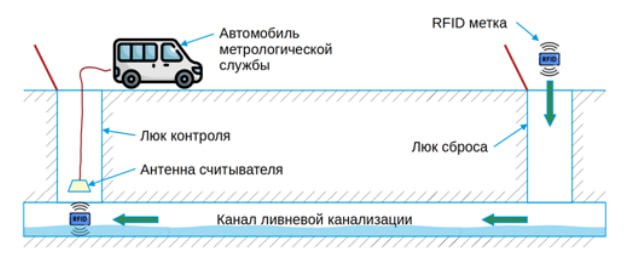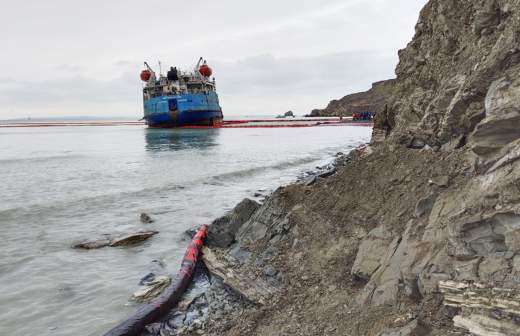- Статьи
- Science and technology
- Counting between drains: RFID tags will protect water bodies from industrial pollution
Counting between drains: RFID tags will protect water bodies from industrial pollution

Scientists from St. Petersburg have come up with a way to combat the problem when industrial enterprises illegally connect their wastewater to storm sewers that do not have sophisticated treatment facilities. The wastewater often contains toxic reagents, heavy metals, oils and other pollutants that end up in water bodies. Specialists suggested using radio tags for this purpose. Ecologists note that it will be possible to talk about the effectiveness of the method only after large-scale practical testing in different conditions.
Radio tags for ecology
Employees of the St. Petersburg Federal Research Center of the Russian Academy of Sciences (SPb FIC RAS) at the request of the Federal State Budgetary Institution "State Research Institute of Industrial Ecology" developed and successfully tested a method of rapid detection of illegal discharge of waste enterprises into sewers and water bodies based on the technology of passive radio frequency identification using encapsulated RFID-tags (radio frequency tags). This is a chip assembly with a small printed antenna, which stores information about the object and allows you to identify it with a special RFID-reader from a distance of several meters.
Protecting water bodies from industrial pollution is a critical task, as they are now the main sources of drinking water for millions of people, animals and plants, the researchers told Izvestia. Their pollution can lead to serious public health problems, as well as to the death of flora and fauna and the destruction of entire ecosystems. Clean water bodies are the most important factor for the successful work of agriculture, fishing, tourism, and for the comfortable life of indigenous peoples living nearby. Protection of water resources from the ingress of toxic substances is regulated by many legislative acts.
However, there are cases when industrial enterprises illegally connect their wastewater to storm sewers that do not have sophisticated treatment facilities. The wastewater often contains toxic reagents, heavy metals, oils and other pollutants that end up entering water bodies through the sewer system.
One way to address this problem is through regular inspections of industrial facilities and monitoring of storm sewers to detect illegal connections to them and prevent pollution. However, most monitoring methods (visual inspection, smoke tests, use of dyes, flow tracking, and chemical analysis of waters) are either expensive or not versatile enough to detect any type of pollution.
- We investigated the feasibility of passive radio frequency identification technology for rapid detection of unauthorized connections and discharges of industrial wastewater into storm sewers. It is based on the use of cheap sensors with built-in RFID tags, whose movement along the sewer pipes can be tracked automatically," Vladimir Dashevsky, a senior researcher at the SPb FIC RAS, told .
Passive RFID tags are characterized by lightness, compactness and cheapness. However, in sewerage conditions, their reading is significantly hampered by the absorption of radio signals by the earth's thickness, as well as the shielding effect of water. Therefore, the main research was aimed at finding the optimal sensor design and ways to reliably read them in storm sewer pipes.
How toxic emissions from enterprises are monitored
The essence of the method is that during control measures, sensors are discharged into the drainage wells of industrial facilities. At the same time, an EPC code is recorded in the RFID tag, characterizing the place and time of discharge of each capsule. If there is an illegal connection of industrial runoff to the storm sewer system, the sensor after some time is in the control well, where its code is read and transmitted to the data processing server.

The proposed approach allows to diagnose several discharges of one sewer in parallel, which distinguishes it from the traditional method associated with the addition of dyes or isotopes to the water. The time and location of the discharge recorded in the memory of each sensor allows its identification and unambiguous determination of its migration path, even if it takes a considerable time.
In order to evaluate how successfully the sensors traverse pipes of different bends, diameters, and fills, several testbeds were assembled to simulate sections of storm sewer system. Overall, this work demonstrated the promise of the proposed method. Based on the information gathered from the stands, the design of the sensor housing was improved.
Then the researchers conducted an experiment on a direct section of a real storm sewer located at the site of the industrial partner of St. Petersburg FIC RAS - LLC "Ecoprom", responsible for the operation of sewage networks of the Obukhovo industrial zone in St. Petersburg.
- The experiments showed that RFID technology works reliably underground: all the sensors that traveled to the control well were repeatedly and reliably read by the reader. However, their travel time through shoals and clogs in pipes can be long and poorly predictable. To increase the speed and convenience of deploying the monitoring system, we equipped an operator's station in a van. Nevertheless, such an offsite station is clearly not enough," says Vladimir Dashevsky.
Therefore, further development of the technology involves the creation of stationary automated complexes that would track sensors in places where storm water drainage systems discharge into water bodies.
Tracking waste discharge
The research may find practical application, but it is possible to judge the effectiveness of this method and the feasibility of practical application only after large-scale practical testing in different conditions, stressed Vladimir Pinaev, a member of the public council at the Ministry of Natural Resources, a member of the public council of the basic organization of the CIS member states on environmental education.
- It is important to realize that the presence of real objects and substances that may be in real conditions can cause interference and error," he said.
In practice, various methods of storm sewer runoff control are used: smoke test, test with the addition of dye, analysis of wastewater and other methods, said Alena Konovalova, an ecologist, assistant of the Department of Environmental Management at the Patrice Lumumba Institute of Ecology of the RUDN Institute of Ecology.
- The method of passive radio-frequency identification can take a worthy place in this series, but it should be determined how economically and technologically effective its application in practice will be, - she said.
According to the idea of the developers, in the future, automated monitoring of the storm water drainage system will allow to promptly detect and fine violators who discharge their emissions bypassing treatment facilities.
Переведено сервисом «Яндекс Переводчик»







